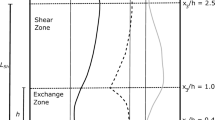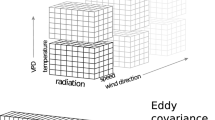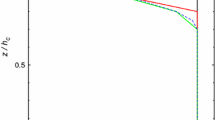Abstract
Double averaged equations for atmospheric boundary layer flows are introduced as natural extensions of single averaged Reynolds equations. We show that in circumstances where double averaged equations are needed, the two fundamental properties of Reynolds averaging are violated. First, we consider double-averaging in free air turbulence, where the aim is to separate coherent motions from background turbulence. We illustrate the different properties of the main operators that have been used and the physical meaning of the terms that result. Second, in canopy flows, the multiply connected nature of the canopy airspace leads to a different set of departures from the standard Reynolds equations. We establish the physical meaning of the extra terms that arise. Finally we briefly discuss the problems, both practical and theoretical, that arise when we use double averaged equations to interpret real data.
Similar content being viewed by others
References
Antonia, R.A. (1981), Conditional sampling in turbulence measurement, Ann. Rev. Fluid Mech. 13, 131–156.
Aubry, N., P. Holmes, J.L. Lumley, and E. Stone (1988), The dynamics of coherent structures in the wall region of a turbulent boundary layer, J. Fluid Mech. 192, 115–173.
Belcher, S.E., J.J. Finnigan, and I.N. Harman (2008), Flows through forest canopies in complex terrain, Ecological Applications (in press).
Bohm, M., J.J. Finnigan, and M.R. Raupach (2000), Dispersive fluxes and canopy flows: just how important are they? Proc. 24th Conference on Agricultural and Forest Meteorology, Amer. Meteor. Soc., Davis, 14–18 August 2000.
Bracewell, R. (1965), The Fourier Transform and its Application, McGraw Hill, New York.
Brown, K.W., and W. Covey (1966), The energy-budget evaluation of the micro-meteorological transfer processes within a cornfield, Agric. Meteorol. 3, 73–96.
Brunet, Y., J.J. Finnigan, and M.R. Raupach (1994), A wind tunnel study of air flow in waving wheat: single-point velocity statistics, Bound.-Layer Meteor. 70, 95–132.
Coceal, O., A. Dobre, T.G. Thomas, and S.E. Belcher (2007), Structure of turbulent flow over regular arrays of cubical roughness, J. Fluid Mech. 589, 375–409.
Corrsin, S. (1974), Limitations of gradient transport models in random walks and turbulence, Adv. Geophys. 18A, 25–60.
Davis, R.E. (1969), On the high Reynolds number flow over a wavy boundary, J. Fluid Mech. 36, 337–346.
Einaudi, F., and J.J. Finnigan (1981), The interaction between an internal gravity wave and the planetary boundary layer. Part I: The linear analysis, Quart. J. Roy. Meteor. Soc. 107, 793–806.
Einaudi, F., A.J. Bedard Jr., and J.J. Finnigan (1989), A climatology of gravity waves and other coherent disturbances at the Boulder Atmospheric Observatory during March–April 1984, J. Atmos. Sci. 46, 303–329.
Finnigan, J.J. (1985), Turbulent transport in flexible plant canopies. In: B.A. Hutchison and B.B Hicks (eds.), The Forest-Atmosphere Interaction, Reidel Publishing Co., Dordrecht, 443–480.
Finnigan, J.J. (1988), Kinetic energy transfer between internal gravity waves and turbulence, J. Atmos. Sci. 45, 486–505.
Finnigan, J.J. (1998), A note on wave-turbulence interaction and the possibility of scaling the very stable boundary layer, Bound.-Layer Meteor. 90, 529–539.
Finnigan, J.J., and F. Einaudi (1981), The interaction between an internal gravity wave and the planetary boundary layer. Part II: Effect of the wave on the turbulence structure, Quart. J. Roy. Meteor. Soc. 107, 807–832.
Finnigan, J.J., and R.H. Shaw (2000), A wind tunnel study of airflow in waving wheat: an Empirical Orthogonal Function analysis of the large-eddy motion, Bound.-Layer Meteor. 96, 211–255.
Finnigan, J.J., F. Einaudi, and D. Fua (1984), The interaction between an internal gravity wave and turbulence in the stably-stratified nocturnal boundary layer, J. Atmos. Sci. 41, 2409–2436.
Fitzmaurice, L., R.H. Shaw, K.T. Paw U, and E.G. Patton (2004), Three-dimensional scalar microfront systems in a large-eddy simulation of vegetation canopy flow, Bound.-Layer Meteor. 112, 107–127.
Gao, W., R.H. Shaw, and K.T. Paw U (1989), Observation of organized structure in turbulent flow within and above a forest canopy, Bound.-Layer Meteor. 47, 349–377.
Holmes, P., J.L. Lumley, and G. Berkooz (1996), Turbulence, Coherent Structures, Dynamical Systems and Symmetry, Cambridge University Press, Cambridge.
Howes, F.A., and S. Whitaker (1985), The spatial averaging theorem revisited, Chem. Eng. Sci. 40, 1387–1392.
Hunt, J.C.R., and D.J. Carruthers (1990), Rapid distortion theory and the ‘problems’ of turbulence, J. Fluid Mech. 212, 497–532.
Kendall, J.M. (1970), The turbulent boundary layer over a wall with progressive surface waves, J. Fluid Mech. 41, 259–281.
Launder, B.E. (1990), Phenomenological modelling: present and future? In: J.L. Lumley (ed.) Whither Turbulence? Turbulence at the Crossroads, Springer Verlag, Berlin, 439–485.
Lemon, E.R., and J.L. Wright (1969), Photosynthesis under field conditions: assessing sources and sinks of carbon dioxide in a corn (Zea Mays L) crop using a momentum balance approach, Agron. J. 61, 405–411.
Le Mone, M.A. (1973), The structure and dynamics of horizontal roll vortices in the planetary boundary layer, J. Atmos. Sci. 30, 1077–1091.
Leonard, A. (1974), Energy cascade in large-eddy simulations of turbulent fluid flows, Advances in Geophysics. 18A, 237–248.
Leslie, D.C. (1973), Developments in the Theory of Turbulence, Oxford University Press, London.
Lumley, J.L. (1967), The structure of inhomogeneous turbulent flows. In: A.M. Yaglom and V.I. Tatarsky (eds.), Atmospheric Turbulence and Radio Wave Transmission, Nauka, Moscow, 161–178.
Lumley, J.L. (1978), Computational modeling of turbulent flows. In: Advances in Applied Mechanics. Vol. 18 (A79-47538 21-34) Academic Press Inc., New York, 123–176.
Moin, P., and R.D. Moser (1989), Characteristic-eddy decomposition of turbulence in a channel, J. Fluid Mech. 200, 471–509.
Moncrieff, J.B., R. Clement, J.J. Finnigan, and T. Meyers (2004), Averaging, detrending and filtering of eddy covariance time series. In: X. Lee, W. Massman, and B. Law (eds.), Handbook of Micrometeorology: A Guide for Surface Flux Measurements and Analysis, Kluwer Academic Publishers, Dordrecht, 7–30.
Penman, H.L., and I.F. Long (1960), Weather in wheat: an essay in micro-meteorology, Quart. J. Roy. Meteor. Soc. 86, 16–50.
Philips, O.N. (1966), The Dynamics of the Upper Ocean, Cambridge University Press, Cambridge.
Raupach, M.R., and R.H. Shaw (1982), Averaging procedures for flow within vegetation canopies, Bound.-Layer Meteor. 22, 79–90.
Raupach, M.R., P.A. Coppin, and B.J. Legg (1986), Experiments on scalar dispersion within a model plant canopy. Part I: The turbulence structure, Bound.-Layer Meteor. 35, 21–52.
Reynolds, O. (1895), On the dynamical theory of incompressible fluids and the determination of the criterion, Phil. Trans. Roy. Soc. Lond. A 186, 123–164.
Reynolds, W.C., and A.K.M.F. Hussein (1972), The mechanics of an organised wave in turbulent shear flow. Part 3: Theoretical models and comparisons with experiments, J. Fluid Mech. 54, 263–288.
Robinson, S.K. (1991), Coherent motions in the turbulent boundary layer, Ann. Rev. Fluid Mech. 23, 601–639.
Shaw, R.H. (1977), Secondary wind speed maxima inside plant canopies, J. Appl. Meteorol. 16, 514–521.
Shaw, R.H., and U. Schumann (1992), Large-eddy simulation of turbulent flow above and within a forest, Bound.-Layer Meteor. 61, 47–64.
Shaw, R.H., J.J. Finnigan, E.G. Patton, and L. Fitzmaurice (2006), Eddy structure near the plant canopy interface, Proc. 27 th Conference on Agricultural and Forest Meteorology, American Meteorological Society, San Diego, California, May 22–25.
Takeuchi, K., E. Leavitt, and S.P. Chao (1977), Effects of water waves on the structure of turbulent shear flow, J. Fluid Mech. 80, 535–559.
Thom, A.S. (1972), Momentum, mass and heat exchange of vegetation, Quart. J. Roy. Meteor. Soc. 98, 124–134.
Tomkins, C.D., and R.J. Adrian (2003), Spanwise structure and scale growth in turbulent boundary layers, J. Fluid Mech. 490, 37–74.
Waggoner, P.E., and W.E. Reifsnyder (1968), Simulation of the temperature, humidity and evaporation profiles in a leaf canopy, J. Appl. Meteorol. 7, 400–409.
Wilson, N.R., and R.H. Shaw (1977), A higher order closure model for canopy flow, J. Appl. Meteorol. 16, 1197–1205.
Woods, J.D. (1968), Wave induced shear instability in the summer thermocline, J. Fluid Mech. 32, 791–800.
Woods, J.D. (1969), On Richardson’s number as a criterion for laminar-turbulent-laminar transition in the ocean and atmosphere, Radio Science 4, 1289–1298.
Wyngaard, J.C. (1982), Boundary layer modeling. In: F.T.M. Nieuwstadt and H. van Dop (eds.), Atmospheric Turbulence and Air Pollution Meteorology, Reidel, Dordrecht, 69–106.
Author information
Authors and Affiliations
Corresponding author
Rights and permissions
About this article
Cite this article
Finnigan, J.J., Shaw, R.H. Double-averaging methodology and its application to turbulent flow in and above vegetation canopies. Acta Geophys. 56, 534–561 (2008). https://doi.org/10.2478/s11600-008-0034-x
Received:
Accepted:
Published:
Issue Date:
DOI: https://doi.org/10.2478/s11600-008-0034-x




